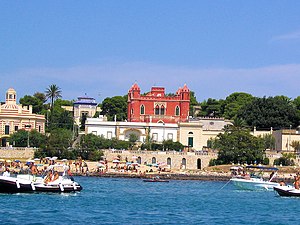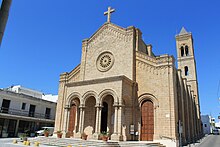Santa Maria di Leuca
| Santa Maria di Leuca | |||
|---|---|---|---|

|
|||
| Santa Maria di Leuca | |||
| Country | Italy | ||
| region | Apulia | ||
| province | Lecce () | ||
| local community | Castrignano del Capo | ||
| Coordinates | 39 ° 48 ' N , 18 ° 21' E | ||
| height | 17 m slm | ||
| Residents | 1,263 (2011) | ||
| Demonym | Leucani | ||
| patron | Holy Mary (August 15) | ||
| Church day | 15th of August | ||
| Telephone code | 0833 | CAP | 73040 |
Santa Maria di Leuca (sometimes just called Leuca ) is a seaside fraction of the Italian municipality of Castrignano del Capo in the province of Lecce , Apulia region .
location
The village has 1263 inhabitants (as of 2011). The Punta Ristola , the southernmost point of Apulia, is located on its territory and represents the intersection between the Ionian and Adriatic Seas and the transition between the Gulf of Taranto and the Strait of Otranto .
Mythology and legends
According to Luigi Tasselli, the name Leuca is derived from the name of the siren Leucàsia ( ancient Greek λευκός = white, bright)
In 1992 the Salento writer and poet Carlo Stasi created a legend (following the above-mentioned connection between Leucasia and the place) about the beautiful siren Leucasia. She had fallen in love with the Messapian shepherd boy Melisso and tried to conquer him with her singing, which no one had been able to resist before. Melisso, however, refused her recruitment because he was in love with the aristocrat Aristula. The siren retaliated by overpowering the two lovers with the waves unleashed by their two tails and drowning them. Their bodies were transformed by the goddess Minerva, who took pity, into the two rocks at either end of the bay, now called Punta Ristola (from the name Aristula) and Punta Meliso (from Melisso), respectively. Thereupon Leukasia lost her voice and killed herself. Her petrified bones form the white cliffs of Leuca.
Peter is said to have come ashore and preached here on his journey to Rome. The Minerva Temple collapsed. The Virgin Mary is said to have helped some boats off the coast in distress, after which "Santa Maria" was placed in front of the name Leuca.
history
The area was already settled in the Paleolithic . In the Grotta del Bambino, in addition to skeletal parts of an elephant, a tooth from a child of the genus Homo neanderthalensis from the Middle Paleolithic was discovered. Traces of Stone Age human activities were also found in other caves.
The Bronze Age fortified settlement named after the Punta Meliso , a cape in the east of the town, was quite important . It stretched across the top of the cape; Remains were mainly discovered next to S. Maria de Finibus Terrae. The settlement emerged during the middle Italian Bronze Age (approx. 1700-1350 BC) and was continuously inhabited until the end of the Bronze Age (11th / 10th century BC). In the end of the Bronze Age, the old defensive wall was possibly abandoned and the center of the settlement shifted to a lower height, closer to the sea, on a terrace about 12 meters above sea level. From this settlement phase , in addition to indigenous impasto goods, which predominate, and southern Italian protogeometric ceramics (earlier usually referred to as Japygic protogeometric ceramics ), many fragments of Mycenaean ceramics originate, which at least testify to more intensive trade with Greece and from the late 12th to the late 11th century BC Date (time stages SH IIIC middle and late as well as sub-Mycenaean ).
Not far from Punta Ristola there are some caves, including the Grotta Porcinara, an artificially built cave in the limestone cliffs, on the walls of which there are many Messapic Greek and Latin inscriptions, which, together with remains of an altar and votive offerings, testify to a cult that took place here for the time between the 8th century BC BC and the 2nd century AD is proven.
There are traces of medieval settlements in various parts of the territory of Leuca. Around the middle of the 16th century, Andrea Gonzaga , the first marquis of Alessano , built the "Torre Vecchia", which was later renamed "Torre degli uomini morti". Philip II of Spain also had a tower built in the 16th century . At that time bands of robbers were up to mischief and several times attacked the population living on the coast. For this reason, coastal settlements were repeatedly abandoned and abandoned and often only inhabited by a few fishermen. Only from 1873 did the interest in this place grow again and from 1874 buildings were gradually built that made Santa Maria di Leuca a larger town, which over time became a popular destination for summer vacationers. Initially, the place was especially popular with wealthy Apulians, as evidenced by some Art Nouveau villas that were built from around 1900.
The Aquedotto pugliese , an aqueduct that supplies large parts of Apulia and Campania with water, ends in Santa Maria di Leuca . It is the largest aqueduct in Europe. Construction began at the beginning of the 20th century; the end point, Santa Maria di Leuca, was reached in 1941.
Attractions
- One of the landmarks of the city is the lighthouse built in 1864 , which stands on Cape Punta Meliso at a height of 102 m above sea level . The lighthouse is 47 meters high, making it one of the most imposing in Italy after the lighthouse in Genoa .
- Basilica Santa Maria de Finibus Terrae , also located on the Cape, was built in its current form between 1722 and 1755 and commemorates Saint Peter , who is said to have made a stopover here on his trip to Rome. The church is consecrated to St. Mary and is named for the place Santa Maria di Leuca. There are previous buildings; the first church was consecrated by Pope Julius I in 343. Originally a temple for Minerva is said to have stood here.
- In the area, often directly on the coast, there are a number of caves, such as the Grotte delle Rade (among these the Grotta del Diavolo and the Grotta Porcinara), the Grotte di Ponente (including Grotta del Drago) and the Grotto Levante, some of which can be visited.
literature
- Mario Benzi : LH IIIC Late Mycenaean Refugees at Punta Meliso, Apulia. In: Vassos Karageorghis - Christine E. Morris: Defensive settlements of the Aegaean and the Eastern Mediterranean after c. 1200 BC , Nicosia 2001, pp. 233-240.
- Carlo Stasi, Leucasia (racconti, leggende e poesie di terra, di mare e d'amore ...) (AGL, Presicce 1993, 1996, 2001). ISBN 88-87809-10-0
Web links
- Information on the official site of the village (Italian)
- Claudia Schulte The Salentine end of the world: Santa Maria di Leuca
- Information about Santa Maria di Leucau on thethinkingtraveller.com
Individual evidence
- ↑ Population figures of the localities in the province of Lecce (based on analysis of the 2011 census)
- ↑ Luigi Tasselli, Antichità di Leuca (Lecce 1693, 1859).
- ↑ Carlo Stasi, Leucasia (racconti, leggende e poetry di terra, di mare e d'amore ...) (AGL, Presicce 1993, 1996, 2001). ISBN 88-87809-10-0 and Carlo Stasi, Leucàsia e Le Due Sorelle (Storie e leggende del Salento) , Mancarella Ed., Cavallino, 2008, 2012. ISBN 9788890366901
- ^ Marco Bettelli, Italia meridionale e mondo miceneo. Ricerche su dinamiche di acculturazione e aspetti archeologici, con particolare riferimento ai versanti adriatico e ionico della penisola italiana. Florence 2002, p. 26 (with further literature).
- ↑ So Reinhard Jung: ΧΡΟΝΟΛΟΓΙΑ COMPARATA. Comparative chronology of southern Greece and southern Italy from approx. 1700/1600 to 1000 BCE Vienna 2006, p. 165 .; different: Marco Bettelli, Italia meridionale e mondo miceneo. Ricerche su dinamiche di acculturazione e aspetti archeologici, con particolare riferimento ai versanti adriatico e ionico della penisola italiana. Florence 2002, p. 26.
- ↑ Benzi 2001, p. 233.
- ↑ Benzi 2001, p. 233.

